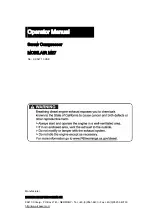
A
PPLICATION
GUIDELINES
O
PERATING
CONDITIONS
Discharge gas temperature
protection (DGT)
DGT protection is required if the high and low
pressure switch settings do not protect the com-
pressor against operations beyond its specific ap-
plication envelope. Please refer to the examples
below, which illustrate where DGT protection is
required (n°1) and where it is not (n°2).
The compressor must not be allowed to cycle on
the discharge gas thermostat. Continuous opera-
tions beyond the compressor’s operating range
will cause serious damage to the compressor!
A DGT accessory is available from Danfoss: refer to
page 39.
The discharge temperature depends mainly on
the combination of evaporating temperature,
condensing temperature and suction gas super-
heat. Discharge gas temperature should be con-
trolled with an isolated thermocouple or thermo-
stat attached to the discharge line 6 inches from
the compressor shell. Maximum discharge gas
temperature must not exceed 275°F when the
compressor is running within the approved oper-
ating envelope.
Maximum discharge gas
temperature
Example 1
(R22, SH = 20°F)
LP switch setting: LP1 = 29 PSI (5°F)
HP switch setting: HP1 = 345 PSI (142°F)
c
The LP and HP switches don't protect suf-
ficiently from operation outside the envelope. A
DGT protection is required to avoid operation in
the hatched area.
Example 2
(R22, SH = 20°F)
LP switch setting: LP2 = 36 PSI (14°F)
HP switch setting: HP2 = 247 PSI (120°F)
d
The LP and HP switches protect from opera-
tion outside the envelope. No DGT protection
required.
23
FRCC.PC.016.A1.22
-30
-20
-10
0
10
20
30
40
50
60
Evaporating temperature (°F)
Condens
ing t
e
m
p
er
at
ur
e (
°F
)
MLZ / MLM
R22 - SH 20°F
50
60
70
80
90
100
110
120
130
140
150
160
Example 1
Example 2
LP1
LP2
HP1
HP2
c
d
Discharge line
Insulation
Bracket
Thermostat
















































